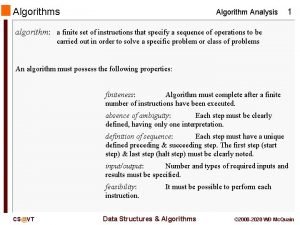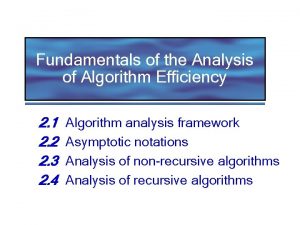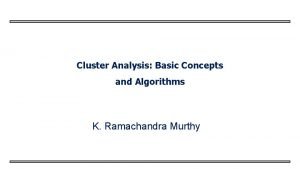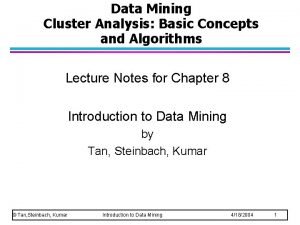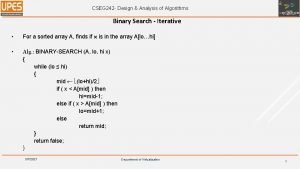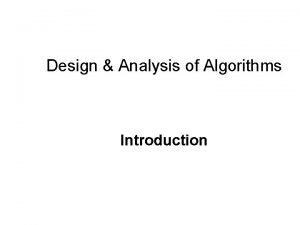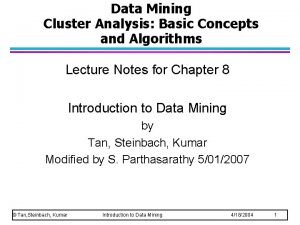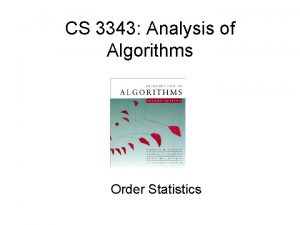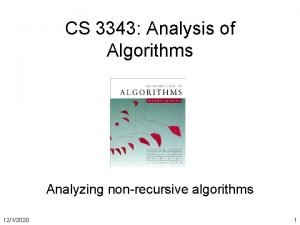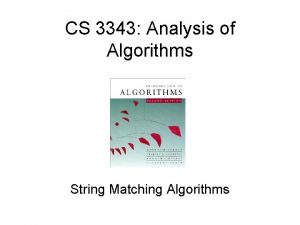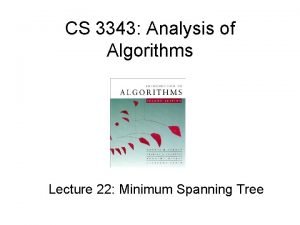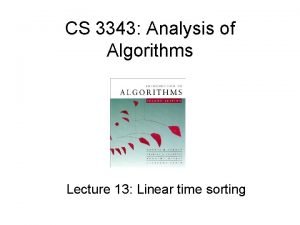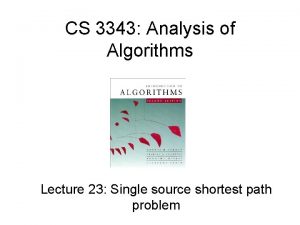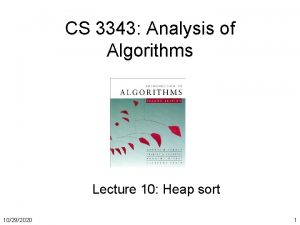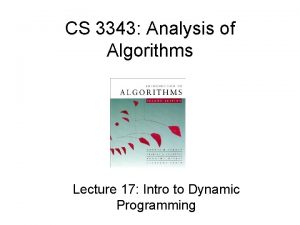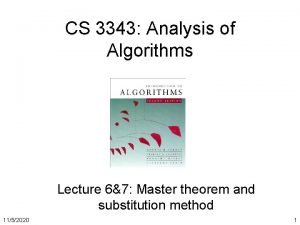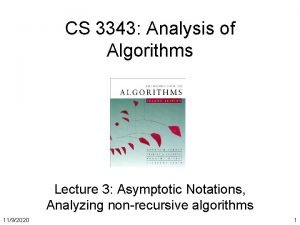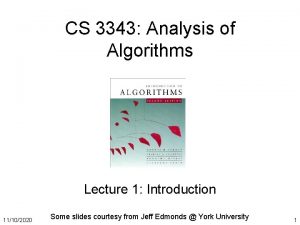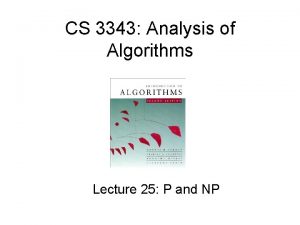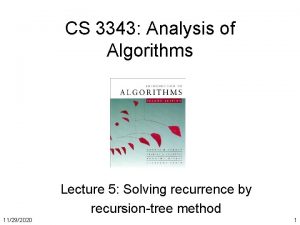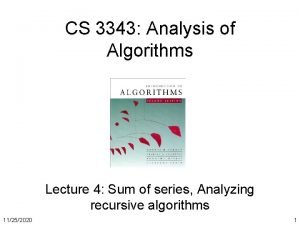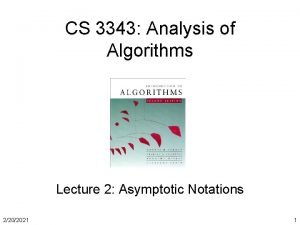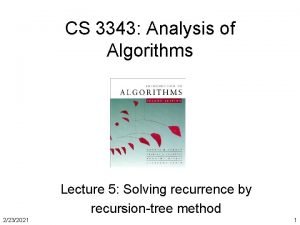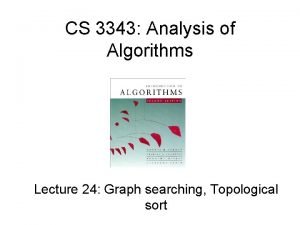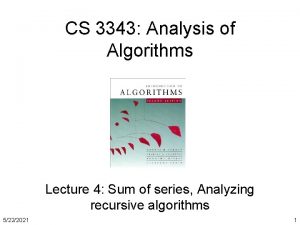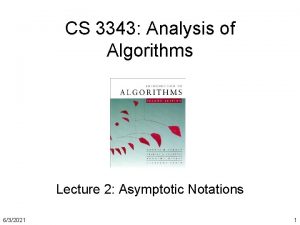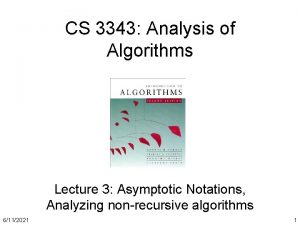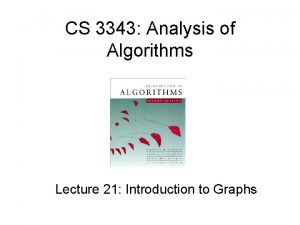CS 3343 Analysis of Algorithms Lecture 14 Order

























- Slides: 25

CS 3343: Analysis of Algorithms Lecture 14: Order Statistics

Order statistics • The ith order statistic in a set of n elements is the ith smallest element • The minimum is thus the 1 st order statistic • The maximum is the nth order statistic • The median is the n/2 order statistic • If n is even, there are 2 medians • How can we calculate order statistics? • What is the running time?

Order statistics – selection problem • Select the ith smallest of n elements • Naive algorithm: Sort. – Worst-case running time Q(n log n) using merge sort or heapsort (not quicksort). • We will show: – A practical randomized algorithm with Q(n) expected running time – A cool algorithm of theoretical interest only with Q(n) worst-case running time

Recall: Quicksort • The function Partition gives us the rank of the pivot k x p x r x q • If we are lucky, k = i. done! • If not, at least get a smaller subarray to work with – k > i: ith smallest is on the left subarray – k < i : ith smallest is on the right subarray • Divide and conquer – If we are lucky, k close to n/2, or desired # is in smaller subarray – If unlucky, desired # is in larger subarray (possible size n-1)

Randomized divide-and-conquer algorithm RAND-SELECT(A, p, q, i) ⊳ i th smallest of A[ p. . q] if p = q & i > 1 then error! r RAND-PARTITION(A, p, q) k r–p+1 ⊳ k = rank(A[r]) if i = k then return A[ r] if i < k then return RAND-SELECT( A, p, r – 1, i ) else return RAND-SELECT( A, r + 1, q, i – k ) k A[r] p A[r] r q

Randomized Partition • Randomly choose an element as pivot – Every time need to do a partition, throw a die to decide which element to use as the pivot – Each element has 1/n probability to be selected Rand-Partition(A, p, q){ d = random(); // draw a random number between 0 and 1 index = p + floor((q-p+1) * d); // p<=index<=q swap(A[p], A[index]); Partition(A, p, q); // now use A[p] as pivot }

Example Select the i = 6 th smallest: 7 10 pivot Partition: 3 2 5 8 11 3 2 13 k=4 5 7 11 8 10 13 i=6 Select the 6 – 4 = 2 nd smallest recursively.

Complete example: select the 6 th smallest element. 7 i=6 k=4 3 10 2 5 5 8 7 11 3 2 11 8 10 8 8 10 13 i=6– 4=2 k=3 Note: here we always used first element as pivot to do the partition (instead of rand-partition). i=2<k k=2 i=2=k 10 11 13

Intuition for analysis (All our analyses today assume that all elements are distinct. ) Lucky: T(n) = T(9 n/10) + Q(n) CASE 3 = Q(n) Unlucky: T(n) = T(n – 1) + Q(n) arithmetic series = Q(n 2) Worse than sorting!

Running time of randomized selection T(n) ≤ T(max(0, n– 1)) + n T(max(1, n– 2)) + n M T(max(n– 1, 0)) + n if 0 : n– 1 split, if 1 : n– 2 split, if n– 1 : 0 split, • For upper bound, assume ith element always falls in larger side of partition • The expected running time is an average of all cases Expectation

Substitution method Want to show T(n) = O(n). So need to prove T(n) ≤ cn for n > n 0 Assume: T(k) ≤ ck for all k < n Therefore, T(n) = O(n) if c ≥ 4

Summary of randomized selection • Works fast: linear expected time. • Excellent algorithm in practice. • But, the worst case is very bad: Q(n 2). Q. Is there an algorithm that runs in linear time in the worst case? A. Yes, due to Blum, Floyd, Pratt, Rivest, and Tarjan [1973]. IDEA: Generate a good pivot recursively.

Worst-case linear-time selection SELECT(i, n) 1. Divide the n elements into groups of 5. Find the median of each 5 -element group by rote. 2. Recursively SELECT the median x of the ën/5û group medians to be the pivot. 3. Partition around the pivot x. Let k = rank(x). 4. if i = k then return x elseif i < k then recursively SELECT the i th smallest element in the lower part else recursively SELECT the (i–k)th smallest element in the upper part Same as RANDSELECT

Choosing the pivot

Choosing the pivot 1. Divide the n elements into groups of 5.

Choosing the pivot 1. Divide the n elements into groups of 5. Find lesser the median of each 5 -element group by rote. greater

Choosing the pivot x 1. Divide the n elements into groups of 5. Find lesser the median of each 5 -element group by rote. 2. Recursively SELECT the median x of the ë n/5û group medians to be the pivot. greater

Analysis x At least half the group medians are x, which is at least ë ë n/5û /2û = ë n/10û group medians. lesser greater

Analysis x At least half the group medians are x, which is at least ë ë n/5û /2û = ë n/10û group medians. • Therefore, at least 3 ë n/10û elements are x. (Assume all elements are distinct. ) lesser greater

Analysis x At least half the group medians are x, which is at least ë ë n/5û /2û = ë n/10û group medians. • Therefore, at least 3 ë n/10û elements are x. • Similarly, at least 3 ë n/10û elements are x. lesser greater

Analysis Need “at most” for worst-case runtime • At least 3 ë n/10û elements are x at most n-3 ë n/10û elements are x • The recursive call to SELECT in Step 4 is executed recursively on at most n-3 ë n/10û elements. 3 ë n/10û Possible position for pivot 3 ë n/10û

Analysis • Use fact that ë a/bû > a/b-1 • n-3 ë n/10û < n-3(n/10 -1) 7 n/10 + 3 3 n/4 if n ≥ 60 • The recursive call to SELECT in Step 4 is executed recursively on at most 7 n/10+3 elements.

Developing the recurrence T(n) Q(n) T(n/5) Q(n) T(7 n/10 +3) SELECT(i, n) 1. Divide the n elements into groups of 5. Find the median of each 5 -element group by rote. 2. Recursively SELECT the median x of the ën/5û group medians to be the pivot. 3. Partition around the pivot x. Let k = rank(x). 4. if i = k then return x elseif i < k then recursively SELECT the i th smallest element in the lower part else recursively SELECT the (i–k)th smallest element in the upper part

Solving the recurrence Assumption: T(k) ck for all k < n if n ≥ 60 if c ≥ 20 and n ≥ 60

Conclusions • Since the work at each level of recursion is basically a constant fraction (19/20) smaller, the work per level is a geometric series dominated by the linear work at the root. • In practice, this algorithm runs slowly, because the constant in front of n is large. • The randomized algorithm is far more practical. Exercise: Try to divide into groups of 3 or 7. Exercise: Think about an application in sorting.
 Analysis of algorithms lecture notes
Analysis of algorithms lecture notes Introduction to algorithms lecture notes
Introduction to algorithms lecture notes Via optica
Via optica 01:640:244 lecture notes - lecture 15: plat, idah, farad
01:640:244 lecture notes - lecture 15: plat, idah, farad 1001 design
1001 design An introduction to the analysis of algorithms
An introduction to the analysis of algorithms Analyze algorithm
Analyze algorithm Association analysis: basic concepts and algorithms
Association analysis: basic concepts and algorithms Input algorithm example
Input algorithm example Algorithm analysis examples
Algorithm analysis examples Analysis of algorithms
Analysis of algorithms Mathematical analysis of non-recursive algorithms
Mathematical analysis of non-recursive algorithms Cluster analysis basic concepts and algorithms
Cluster analysis basic concepts and algorithms Randomized algorithms and probabilistic analysis
Randomized algorithms and probabilistic analysis Introduction of design and analysis of algorithms
Introduction of design and analysis of algorithms Cluster analysis basic concepts and algorithms
Cluster analysis basic concepts and algorithms Cjih
Cjih Goals of analysis of algorithms
Goals of analysis of algorithms Cluster analysis basic concepts and algorithms
Cluster analysis basic concepts and algorithms Binary search in design and analysis of algorithms
Binary search in design and analysis of algorithms Introduction to the design and analysis of algorithms
Introduction to the design and analysis of algorithms Competitive analysis algorithms
Competitive analysis algorithms Design and analysis of algorithms
Design and analysis of algorithms Design and analysis of algorithms
Design and analysis of algorithms Cluster analysis basic concepts and algorithms
Cluster analysis basic concepts and algorithms Comp 482
Comp 482









